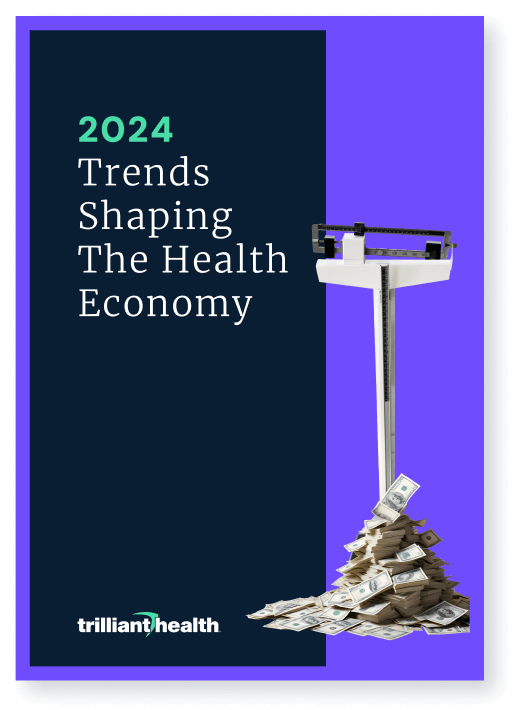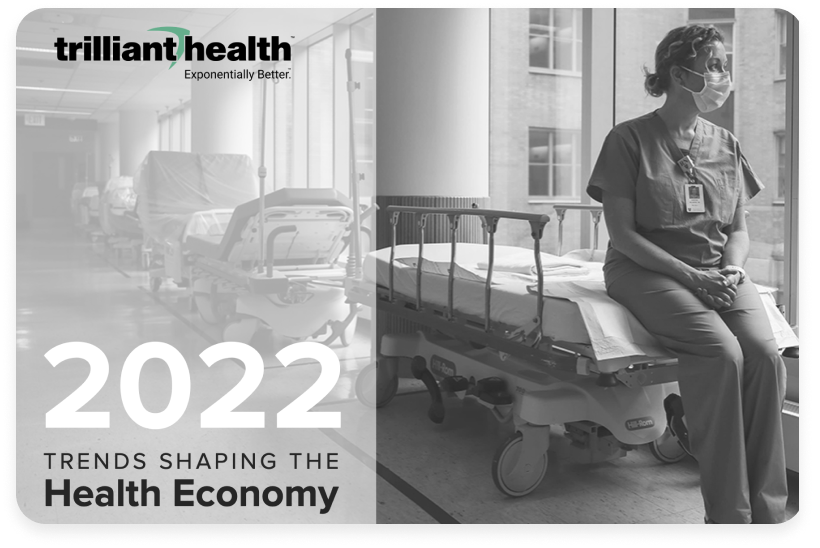Press Releases
Trilliant Health | October 19, 2022Trilliant Health’s Second Annual Trends Shaping the Health Economy Report Details Major Economic and Market Forces Defining U.S. Healthcare
Demand for primary care and surgical care services remains below pre-pandemic levels; visit volume loss caused by COVID-19 may be permanent
Declining number of commercially insured patients, persistent excess mortality, population migration, and increased competition from leading retailers continue to pose competitive threats to traditional providers
Demand for behavioral health is increasing post-pandemic and remains the primary driver of telehealth utilization
Demand for women’s health services among commercially insured patients in 31-40 age cohort remains higher post-pandemic, masking softer demand in other patient cohorts
Antidepressant and anxiety prescribing grows, replacing opioids as second-most common
BRENTWOOD, TN – October 18th, 2022 – Trilliant Health, the leading predictive analytics and market research firm in the healthcare industry, today released its second-annual Trends Shaping the Health Economy report, outlining 13 trends influencing the healthcare industry. Trilliant Health’s analysis found that several long-term trends were significantly amplified or accelerated by the COVID-19 pandemic, creating challenges for every stakeholder in the health economy.
The Trilliant Health 2022 Trends Shaping the Health Economy report leverages extensive data analysis from a variety of sources, including third-party resources and the company’s proprietary all-payer claims database that informs longitudinal patient journeys for more than 300 million Americans.
The report details how every health economy stakeholder is affected by competing in a negative-sum game as the number of commercially insured individuals decreases, healthcare costs continue to rise, and patients have a growing number of providers to choose from, including new retail entrants like CVS, Walmart and Amazon. The report synthesizes the impact of these trends, which were accelerated and amplified by the pandemic, to arm healthcare leaders with the knowledge to lead their organizations through an era of declining yield.
“For decades, commercially insured patients have been the lifeblood of the health economy, and the secular decline in the percentage of that group is detrimental for every health economy stakeholder. Additionally, Americans have been slow to return to primary care and preventive screenings post-pandemic, and many of those who have returned are choosing urgent care and retail clinics in lieu of traditional primary care providers,” said Trilliant Health CEO Hal Andrews. “As leading retailers and payers begin to commoditize low-acuity services and the Congressional Budget Office analyzes the effect of price caps on medical reimbursement, the business model of every health economy stakeholder is pressured. Our annual report helps health economy stakeholders to understand which macro trends will affect them the most.”
Some of the most important findings within the report include:
Primary care growth projected to be anemic as new entrants flood supply
The national median incidence rate for primary care is projected to nominally increase (1.7% CAGR) between 2022 and 2026. As a result, by 2026, Americans are projected to need 1.2 primary care visits per year on average, which is only 0.1 more visits above observed 2021 levels.
While demand for primary care services varies significantly across core-based statistical areas (CBSAs), a majority (62%) of CBSAs have experienced primary care volume declines compared to pre-pandemic levels. These declines and variances were driven by several factors, including population migration, excess mortality rates in adults, and foregone care due to COVID-19 which is now permanently lost.
The Trilliant Health report also reveals how COVID-19 volumes underpin the massive increase in urgent care volumes that occurred over the past two years. While urgent care volume was 31% higher in Q1 2022 compared to Q1 2019, almost half of utilization is attributable to COVID-19. As a result, urgent care volumes represent a larger proportion of a declining number of primary care encounters. Notably, after removing COVID-19-related care (vaccines, testing and treatment) and behavioral health services, all other combined healthcare encounters were down by 6.2% between Q1 2019 and Q1 2022.
As demand for healthcare services lags, several established retailers have entered the primary care market, including Amazon, Walmart and CVS. These retailers have millions of customers, a national presence, and enterprise scale, representing a significant threat to traditional providers like hospitals and health systems. However, Trilliant Health’s report also shows why these new entrants will face extreme competition among each other for the select demographic and psychographic cohorts that represent healthcare demand.
Provider organizations should prepare for slower demand growth in major surgical services
In contrast to perennial forecasts of 3-5% growth, Trilliant Health’s report highlights how national median incidence rate for major surgical service lines are projected to increase nominally (2% CAGR) between 2022 and 2026. For example:
- Despite rapidly rising obesity rates in America, the national median incidence rate for heart/vascular surgical services is projected to increase modestly by 2% CAGR between 2022 and 2026. As a result, in 2026 only 1.7% of the U.S. population will require a heart/vascular surgical service, which is 0.2 percentage points above observed 2021 levels.
- The national median incidence rate for OB/GYN surgical services is projected to increase slightly by 2% CAGR between 2022 and 2026. As a result, in 2026 only 2.4% of Americans will require OB/GYN surgical services, which is 0.3 percentage points above observed 2021 levels.
Fewer cancer screenings over the past two years suggest that higher patient acuity will manifest in the future, which correlates with recent M&A transactions in the pharmaceutical industry.
Cancer mortality rates may have declined recently, but Trilliant Health’s report shows there were fewer cancer screenings over the past few years for many of the most prevalent cancer diagnoses. For instance, cervical cancer screenings declined most dramatically, declining by 26.5% from 2019 to 2020 and again by 11.3% from 2020 to 2021.
Behavioral health demand continues to outpace other healthcare service lines
While Trilliant Health’s report demonstrates that demand for healthcare services is consistently and almost universally declining, the behavioral health sector is still surging. Visit volume nationally has remained more than 15% above pre-pandemic levels.
Trilliant Health’s report also indicates that prescriptions for behavioral health conditions are increasing. In 2021, antidepressant and antianxiety prescribing represented approximately 19% of seven selected drug classes analyzed, surpassing opioids (15.4%) in rank, which previously were prescribed at a higher rate.
Market for women’s healthcare represents bright spot, despite variances in age group cohorts
While demand for all women’s healthcare declined during the early days of the pandemic, visit volumes have stabilized above pre-pandemic levels. In Q1 2022, women’s healthcare visits were up nearly 2% compared to Q1 2019. For routine women’s healthcare services, demand was up 31.6% between January 2021 to March 2022 compared to January 2019 to March 2020 – with volumes higher in 88% of CBSAs. Additionally, demand for behavioral health services among women increased by more than 26% in January 2021 to March 2022 compared to January 2019 to March 2020.
However, while women are engaging in routine healthcare services, women still account for a higher share of patients without a primary care relationship than men (53% vs 47%). Additionally, women and men are returning to care in different settings. Men are disproportionately using urgent care while women are more likely to be returning to non-hospital outpatient settings like retail clinics.
Provider burnout is exacerbating the long-standing physician supply shortage
The physician workforce is changing for many reasons, with the pandemic appearing to exacerbate burnout. Trilliant Health’s analysis finds that between 2019 and 2022, 9.8% of physicians (M.D. or D.O.) stopped practicing. When accounting for the number of new physicians entering the workforce during the same period, the report finds that the U.S. saw a net -2% reduction in the physician workforce.
Telehealth demand remains below pandemic highs - despite behavioral health growth
Even as the number of telehealth suppliers continues to increase, demand for telehealth services was 37% lower in Q1 2022 compared to its peak quarter in 2020. Nearly half (48.7%) used telehealth only once, while 80.5% accessed telehealth fewer than five times.
Conversely, tele-behavioral health visit volume remains consistent. Nearly 60% of telehealth visits were related to behavioral health concerns in Q1 2022 as compared to 32.4% in Q1 2019. Tele-behavioral health also is changing prescribing trends. In 2020 and 2021, 35% of all antidepressant and anxiety prescriptions occurred after a telehealth encounter, as compared to only 1% in 2019.
“As a health economist, I analyze the industry through the lens of supply and demand, and for too long, it has operated as if the laws of supply and demand did not apply. Health economy stakeholders will extrapolate discrete data points to the entire market and will formulate flawed strategies as a result,” said Trilliant Health Chief Research Officer and SVP of Market Strategy Sanjula Jain, Ph.D. “The cumulative effect of the 13 secular trends contained in this report conclude that every stakeholder – from providers to medical device makers - must be prepared for reduced yield, which have a significant impact on growth strategies across the health economy.”
Journalists can reach the Trilliant Health media team at: media@trillianthealth.com
- Press Release

























